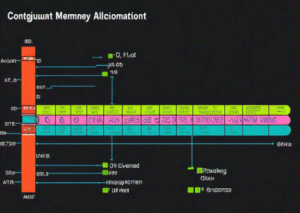Contiguous memory allocation is a method used by operating systems to manage memory. It means that each process gets a single continuous block of memory.
This technique helps in managing memory more easily but can have some challenges too.
By understanding how contiguous memory allocation works, you can learn about how your computer runs programs efficiently.
In this article, we will explain contiguous memory allocation in simple terms, covering its benefits, drawbacks, and how it compares to other methods.
Basic Concept
Contiguous memory allocation means that when a process needs memory, it is given a single block of memory that is all together, or contiguous.
This is like giving a person a single room to live in, instead of several small rooms spread out.
It helps the computer keep track of where everything is and makes accessing data faster.
“Contiguous memory allocation keeps each process’s memory in a single continuous block.”
How It Works
When a program runs, the operating system looks for a big enough block of free memory to fit the whole program.
It then allocates this block to the program.
If the program needs more memory later, the operating system tries to find a larger block, which means it might need to move other programs around.
Advantages
One big advantage of contiguous memory allocation is its simplicity.
Because all the memory for a process is in one place, it is easy for the operating system to manage and for the program to access.
This method can make the computer run faster because it doesn’t have to spend time looking for where the next piece of data is stored.

Disadvantages
However, there are also some disadvantages. One problem is that it can lead to wasted space.
This happens when there are small gaps of unused memory between blocks, known as fragmentation.
Another issue is that if a program needs more memory than what is available in a single block, the operating system might not be able to provide it, even if there is enough total free memory in smaller pieces.
Comparison to Non-Contiguous Allocation
Non-contiguous memory allocation is different because it allows a process to be split up into several pieces of memory that can be spread out.
This can reduce fragmentation and make better use of available memory.
However, it is more complex for the operating system to manage and can slow down the computer because it has to keep track of where all the pieces are.

Real-Life Examples
Think of contiguous memory allocation like arranging books on a shelf. If you have all your books in one big row, it’s easy to find the one you want.
But if you only have small spaces here and there, you might have to split your books up and put parts of them in different places. This can make it harder to find a specific book quickly.
FAQs
What is contiguous memory allocation?
Contiguous memory allocation is a memory management technique where each process is given a single continuous block of memory.
This method is simple and helps in managing memory efficiently, but it can lead to fragmentation and other issues.
How does contiguous memory allocation work?
In contiguous memory allocation, when a program runs, the operating system allocates a single large block of free memory to the program.
If the program needs more memory later, the operating system looks for a larger block and may need to move other programs around to make space.
What are the advantages of contiguous memory allocation?
The main advantages of contiguous memory allocation are its simplicity and speed. Because all the memory for a process is in one place, it is easy to manage and quick to access, making the computer run more efficiently.
What are the disadvantages of contiguous memory allocation?
The disadvantages include fragmentation, where small gaps of unused memory are left between blocks, and difficulty handling large memory requests if a big enough continuous block of memory is not available.
How does contiguous memory allocation compare to non-contiguous allocation?
Non-contiguous memory allocation allows a process to be split into several pieces of memory that can be spread out, reducing fragmentation and making better use of available memory.
Conclusion
In conclusion, contiguous memory allocation is a simple and efficient way for operating systems to manage memory, but it has some drawbacks like fragmentation and difficulty handling large memory requests.
Understanding this concept helps you see how your computer organizes and uses its resources to run programs smoothly.
Whether using contiguous or non-contiguous memory allocation, each method has its trade-offs, and knowing them can help you appreciate the complexities of computer memory management.









